To open the OPC Item /Browse import
3.
Select Item / Browse icon ![]()
4. The OPC Item Browse / Import Dialog Panel opens.
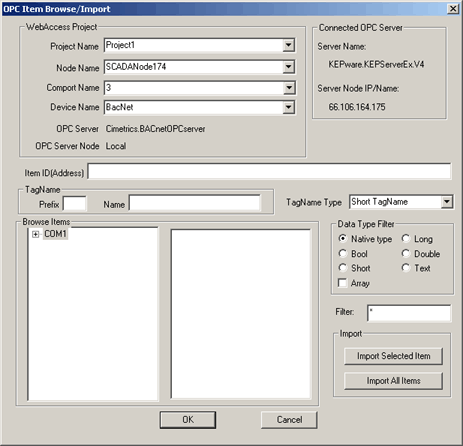
Figure 3-20OPC Toll - Browse Items
5. Select the desired Project from the pull down list (if you have more than one Project). The first project, listed alphabetically, is selected by default.
6. Select the SCADA node from the list (if you have multiple SCADA Nodes). This SCADA node will collect data from the OPC Server. The SCADA node must have an OPC Comport configured to the OPC Server you are connected with now.
7. Select the Comport configured to this OPC Server.
The OPC Server and Server Type will change to reflect the configuration of the Comport. If the selected Comport is configured for an OPC Server, the OPC Server named and OPC Server Node type appears.
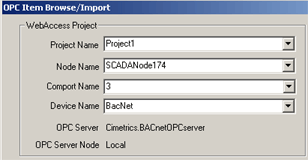
Figure 3-21ComPort 3
configured for Cimetrics Bacnet OPC Server
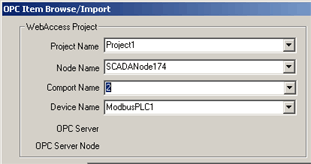
Figure 3-22Comport 2 - no OPC Server configured
8. Confirm that the SCADA Node / Comport you have selected is configured for the OPC Server you have connected the OPC Tool.
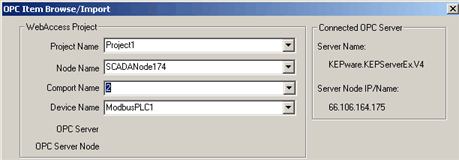
Figure 3-23OPC Tool - Connected OPC Server Name should match your device
The COM Port’s OPC Server is listed in the WebAccess Project information area below the Comport and Device Name.

Figure 3-24Device Information - Project, SCADA Node, Comport, Device Name, OPC Server
The Connect OPC Server area shows the OPC Server the OPC Tool is connected (see the Top Right of dialog box).

Figure 3-25Name of OPC Server you are browsing
9. Select the Type of Tag Name Conversion (sic Tag Name Type). WebAccess Tag names are limited to 15 characters and the OPC Item names are often much longer.

Figure 3-26Convert Tag Names recommended
a. Short Tagname will use the OPC Data Point name (the Panel on Right) as the Tag Name. If the same Data Point has already been selected from another item, WebAccess will append a sequential number to the tag name.
b. Convert Tagname will use both the Item Name and Data Point Name plus conversion rules create a Tag Name. The conversion rules are described in the OPCTol.ini file. The Convert Tag Name will give you the greatest control in creating tag names automatically. Please see section OPC TOOL INI file of Conversion Rules, section 3.5.3.1
c. Sequential Tagname will number the tag consecutively: Tag1, Tag2, etc. If you modify the Tagname field (i.e. replace TAG), the tool will append a number to the name you enter and track the number of previous tag name roots.
d. ItemID will use the OPC Item Name (from the Panel on Left) for any Data Point selected (from Panel on Right). This is typically used when the same Data Point (e.g. present value) is selected for all Items and the Item Name is the desired Tag. Sequential Numbering of the Tag Name will occur if multiple Data Points are selected from the same Item (e.g. device_1967__analog_I, device_1967__analog01, device_1967__analog02).
Underscores (_) will replace Blanks (white spaces) in OPC Item and Data Point names.
10. Add a Prefix, if desired. Prefix is limited to 2 characters max.
![]()
Figure 3-27Add Prefix to Tag Names
This prefix will be the leading characters of the WebAccess Tag Name. For example, Prefix of 49 will yield tagnames: 49TIC101, 49PIC202, 49YS333 etc.
The Prefix is commonly used to help users distinguish between multiple process units that have identical OPC naming conventions inside each process unit (for example 10 Air Handlers, all with identical control databases and OPC data point names).
11. For Data Type Filter, new users are recommended to select Native Type (the default) and use the wildcard (*) for the Filter.
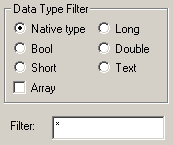
Figure 3-28filter the OPC Tag Items
The Data Type Filter will limit the Data Points listed to only the Data Type selected (Boolean, Long Integer, etc).
The Filter will limit the Data Points Listed to only those Names that meet the filter requirement (F
12. Select an OPC Item (Panel on Left) under Browse Items.
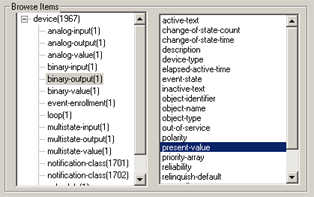
Figure 3‑29OPC Item Tree and Tags
13. Select a Data Point (Panel on Right) associated with the selected OPC Item. Notice that the List of Data Points (Right Panel) changes as you select different Browse Items (Left Panel).
Note that each Item in an OPC Server can have multiple data points associated with it.
14. The proposed TAGNAME appears in the Tagname field (less any Prefix). Modify the Tagname if desired.

Figure 3-30OPC Item ID and WebAccess Tagname
15. Item ID (Address) describes the addressing that will be used to read data from the OPC Server. It is recommended to accept this without modification.
16. Click the Import
Selected Items button. ![]()
17. Select another OPC Item, and repeat steps 9 to 15 until all desired tags are imported.
18. Select OK to
confirm the Import of tags to WebAccess.
If you press Cancel, all tags imported since your first started the
Add/Import Tags will be aborted.
19. The OPC Tool Client will list the Tag Names imported and the OPC Item addresses.
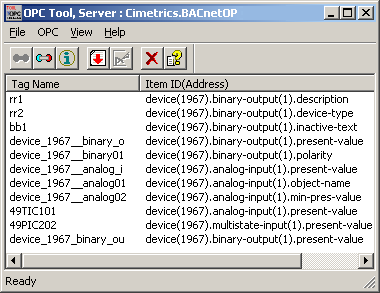
Figure 3-31Imported OPC Tags – OPC Tool
20. You can have the WebAccess Project Manager open while using the OPC Tool to import Tags.
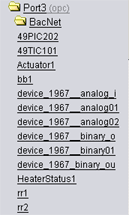
Figure 3-32Imported OPC Tags - Project Manager
By closing and opening the OPC Port Icon, in the Project Manager, you will refresh the tag list and see the Tags that you have imported. Once Imported, you can rename these tags, assign alarms, etc. You can also Delete imported tags and then re-import them allowing you to experiment with naming conversions, etc.